
Build My LED is a newcomer to the aquarium lighting market. This company, based in Austin, Texas, is unique in that they offer the consumer the option of custom-configuring their lighting system. With 18 different LEDs to choose from, this allows a choice of 565,000,000 light combinations according to the website. Their lighting fixtures can also be used for horticulture, commercial and light therapy applications, in addition to aquarium lighting.
These options are currently available, and their tutorial will walk you through making your choices.
Lighting fixtures (luminaires) are available in lengths of:
- 12″ (30cm)
- 24″ (60cm)
- 36″ (90cm)
- 48″ (120cm)
Lens options allow the hobbyist to choose beam angles of:
- 30
- 45
- 60
- 75
- 90
LEDs
Build My LED uses LEDs from Luxeon Rebel and Rebel ES Philips Lighting along with those made by Everlight Shuen Electronics. While Philips is a household name, the latter company may need an introduction – Everlight is based in Taipei, Taiwan and has had an international presence since 1983. Everlight is one of the 10 largest LED companies in the world. ‘Shuen’ is Chinese for ‘shiny’ or ‘bright’.
A multitude of LED spectrum options are available enabling the user to select almost any conceivable color. These include:
- Warm White (2,700K, 3,000K, 3,500K)
- Neutral White (4,000K, 4,500K)
- Cool White (5,000K, 5,700K, 6,500K)
- Ultraviolet (405nm)
- Royal Blue (450nm)
- Blue (470nm)
- Cyan (505nm)
- Green (525nm)
- Amber (590nm)
- Orange (615nm)
- Red (625nm)
- Deep Red (660nm)
- Far Red (730nm)
Fifteen LEDs are installed per foot (30cm) of fixture length.
Luminaire Dimensions
The fixture tested in this review has the following dimensions:
- 1.25″ tall (32mm)
- 1.97″ wide (50mm)
- 48.03″ long (~122 cm)
- Cord length (luminaire to transformer) = 104″ (~2.6m)
- Transformer to plug = 28″ (71cm)
Optical Design
While Build My LED offers five beam angles to handle various lighting applications, I selected the 60 degree beam angle for my fixture.
Reason for Choosing Particular Colored LEDs
I get many emails asking a simple question: What is the best light? Unfortunately, there is no simple answer. If we discount the highly subjective personal preferences of light quality, the answer involves doing some homework on which types of photosynthetic organisms are maintained. For instance, the light quality required for terrestrial plants differs slightly from that needed by, say, zooxanthellae. The question of showcasing the variable fluorescence found in many corals is often a consideration. I offer the following in order to briefly touch on the subject.
Ultraviolet (Max. Wavelength ~405nm): Although Photosynthetically Active Radiation (PAR) is defined as those wavelengths 400 nanometers and above, chlorophyll a absorbs wavelengths to at least 350nm (Jeffrey et al., 1997). These wavelengths will also excite fluorescence in many of the coral fluorescence proteins.
Effect of Lens on UV Transmission
Acrylic materials often attenuate (weaken by absorption) ultraviolet wavelengths. This is not the case with the material used by Build My LED – no cutoff point is apparent at wavelengths below 380nm. Most of the radiation generated by the UV LED is in the visible range. See Figure 1.
Royal Blue/Blue (Max. Wavelength ~450/470nm): Chlorophylls found in zooxanthellae (chlorophylls a and c²) absorb blue wavelengths. Chlorophyll a (also found in terrestrial and freshwater plants) absorbs blue light at ~430nm while chlorophyll c² absorbs maximally at 450nm. These numbers shift by a few nanometers according to the solvent used to dissolve chlorophylls for testing. The accessory pigment peridinin absorbs light at a maximum of ~460nm. Chlorophyll b (found in terrestrial and aquatic plants) absorbs blue light at ~457nm. See Figure 2.
Cyan/Green (Max. Wavelength ~505/525nm): Peridinin (an accessory pigment found in zooxanthellae and associated with chlorophyll a) absorbs light at a maximum of 456nm and up to ~485nm (green-blue). This wavelength falls between the maximum produced by blue and green (or white LEDs). Cyan or green LEDs would be a good choice for those wishing to mimic a turbid coral reef environment. See comments on limits of light production by green LEDs below.
Red (Max. Wavelength ~625nm): Chlorophyll a absorbs red wavelengths at a maximum of ~662nm with a small shoulder at ~617nm. Chlorophyll c² has a small absorption peak at ~630nm.
Deep Red (Max. Wavelength ~660nm): Chlorophyll a absorbs light at a maximum of ~662nm. For terrestrial and freshwater plant enthusiasts, chlorophyll b absorbs red light at a maximum of ~646nm.
Far Red (Max. Wavelength ~730nm): Under conditions of saturating or super-saturating light intensities, far red light (absorbed mostly by photopigments associated with Photosystem I) will prevent a ‘traffic jam’ of electrons within Photosystem II. The use of this light by zooxanthellae is speculative on my part, but remains an interesting possibility.
White (Broad Spectrum,400-700nm): LEDs emitting ‘white’ light are actually blue LEDs coated with a phosphor that absorb blue light and fluoresce it in a broad bandwidth. ‘White’ LEDs are quite popular in luminaires built for aquaria. I chose these to offset the blueness of the light and to add small amounts of light in the yellow to red portion of the spectrum. Interestingly, the first luminaire I ordered contained green LEDs to excite the zooxanthellae accessory photopigment peridinin. After a discussion with Build My LED co-owner Nick Klase, I was advised to add neutral white LEDs to the blue ones, as these would be a more efficient source of green light (and the spectrum of this fixture is subjectively very pleasing). In the LED industry, the low quantum efficiency of green LEDs is known as the ‘Green Gap’. Blue and Red LEDs are very efficient, but scientists have yet to produce green LEDs that exhibit similar radiometric efficiencies. As a footnote, I tested the cool white LEDs and found them to be 7,123K with a CRI of 87.

Figure 2. Spectral signature of a custom-built LED fixture containing 450nm, 470nm and 4,500K ‘neutral white’ LEDs.
Light Intensity of a Custom LED Fixture
Although the two are closely linked, calculating light intensity required for corals or other photosynthetic organisms is much a much less complicated subject than spectral quality. I have written on this subject and reported data obtained by Pulse Amplitude Modulation (PAM) fluorometry. Generally, most corals will do quite well when maintained light fields of intensities ranging from 100 to 500 µmol·m²·sec (~5,000 to 25,000 lux). Tridacna clams (with their thick mantles and self-shading of zooxanthellae) are generally tolerant of more light.
Figure 3 demonstrates the light intensity of a 48″ custom luminaire from Build My LED containing LEDs generating light at 450nm, 470nm and 4500K neutral white.
The 60 degree beam angle on my fixture was able to produce PAR values in excess of 550 µmol·m²·sec, which is a very high number considering the fixture only consumes approximately 75 electrical watts. If you need even more PAR, the intensity maps on the company’s website claim the 30 degree beam angle can deliver over 1,300 µmol·m²·sec at the same mounting height across the length of the fixture.
In addition to high light levels, Build My LED has been able to solve two of the issues prevalent with LED fixtures in the aquarium industry. Looking at Figure 3, you will not see any lateral hotspots in the intensity map. Build My LED fixtures produce very uniform light across the entire aquarium, which is in contrast to the hotspots associated with the LED ‘cluster’ design currently utilized by many fixture manufacturers. The cluster design is used to avoid color separation in the aquarium (which is often referred to as the disco effect), but Build My LED utilizes a proprietary optical system design that eliminates the disco effect in the aquarium.
See Figures 4 and 5 for information on light intensities at various depths in an aquarium.
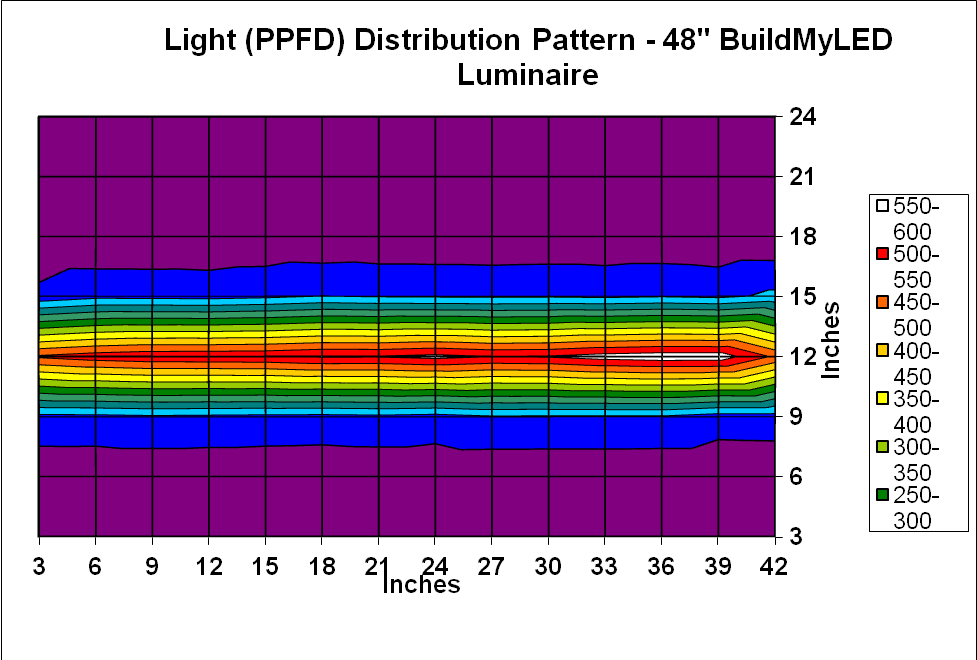
Figure 3. Light Distribution (PPFD) of a 48″ Build My LED luminaire situated 3″ (1.2 cm; in air) above the quantum sensor.
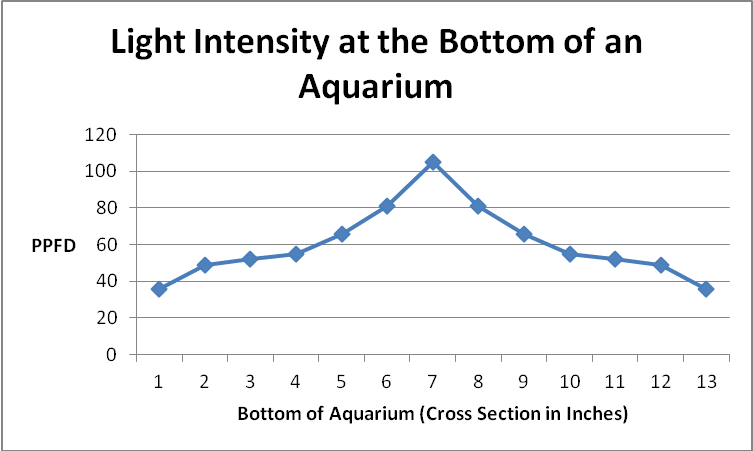
Figure 4. Light intensity (PAR, µmol·m²·sec) at depth (17.5″, or 6.9 cm) and fixture 2.5″ (1 cm) above water level. Note this displays a cross section of the aquarium.
Dimming
If you want to adjust your light levels, Build My LED fixtures are dimmable with 0-10V controllers. The company offers a manual dimmer for $39.99, and the fixtures can also be dimmed with many of the control systems in the aquarium market.
Effect of Temperature on Light Production
Heat is an enemy of LEDs. Light output decreases with increasing temperature (the same can be said for fluorescent lamps), so care must be taken in order to maintain a proper temperature range. Build My LEDs has taken an approach that does not utilize cooling fans but instead relies upon dissipation of heat through a heat sink. This sink, an array of cooling fins, does a good job of getting heat away from the luminaire.
I was interested in examining how well this heat sink worked and conducted a simple experiment. The luminaire was plugged in and its temperature was monitored with an infrared non-contact thermometer every five minutes. A small fan was aimed at the fixture when temperature had reached its maximum (96F in an air-conditioned room).
See Figures 6 and 7.
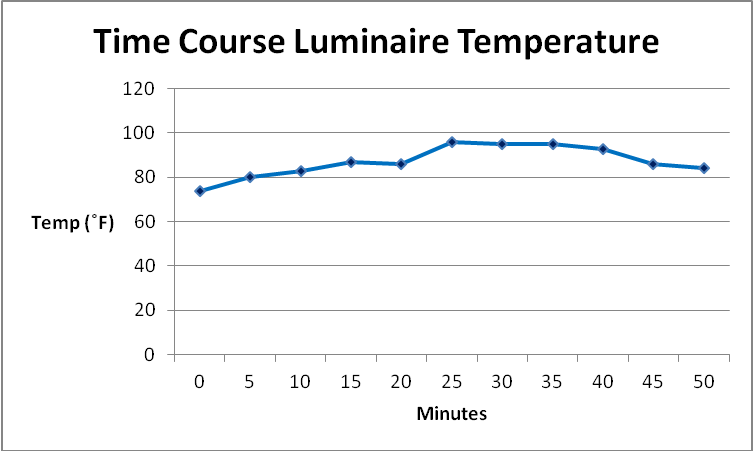
Figure 6. Temperature of the luminaire. Room temperature was maintained at 74F. A small fan was directed at the luminaire at the 35 minute mark. See Figure 7 for details.
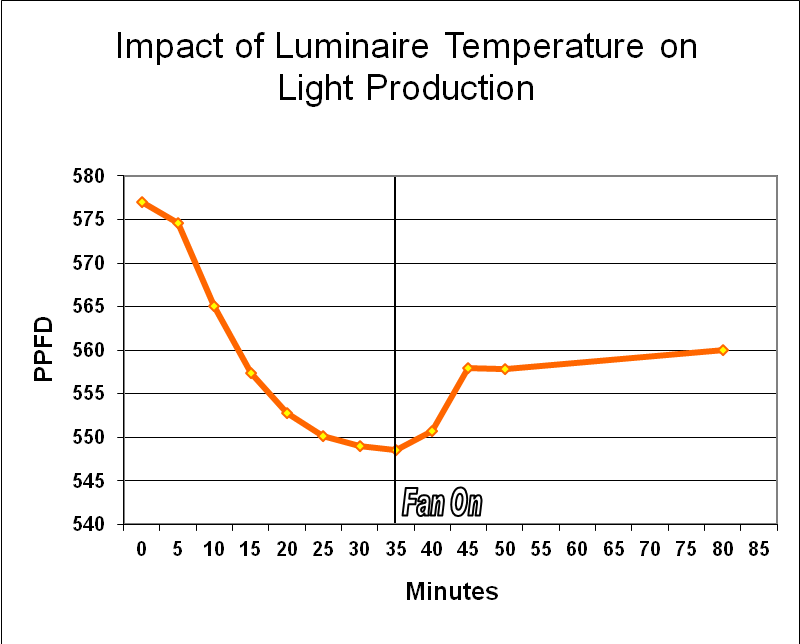
Figure 7. Effects of luminaire temperature on PPFD. Heat dissipation is very good and results in minimal light loss.
I also checked the temperature of the driver during this procedure and found it to be about the same as the luminaire.
Construction
The luminaire is constructed of aluminum with plastic end caps. Ingress Protection Code (sometimes called the International Protection Code) is a system to describe an electrical component housing’s ability to exclude dust and moisture. It consists of two digits – the first is for dust (scale of 0 – 6), and the second is for moisture (scale of 0 – 8). The rating for the luminaire itself is IP66, meaning the enclosure is dust tight and allows no ingress. In addition, the moisture resistance rating of ‘6’ means the enclosure allows no ingress of water when water is sprayed from a water jet of 12.5mm (or ½”) diameter from any direction at a pressure of 100 kPa (14.5 psi) and a flow rate of 100 liters (26 gallons) per minute at a distance of 3 meters (10 feet) for at least 3 minutes without harmful effect. IP66 is equivalent, in respect to dust and water ingress, to a NEMA (National Electrical Manufacturers’ Association) 4 or 4X enclosure. A rating of IP66 does not mean protection against immersion or mean ‘waterproof’. The driver/ ballast carries a rating of IP67, meaning it can be immersed in water of up to 1 meter (~3 feet) deep for a short period of time without harmful effects.
I don’t mean to suggest that reasonable care shouldn’t be exercised in order to avoid water ingress into any electrical device, but it is nice to know that these fixture and driver are built to tight standards.
Discussion
It is often advertised that LEDs have a useful life of 50,000 hours and it would be easy for a hobbyist to expect a light fixture to last something on the order of 10 years. Unfortunately, this has not been the case with many LED fixtures. Too often, cooling fans fail or the power supply dies. In a day where many LED fixtures are being offered with more and more frills, Build My LED offers no-nonsense lighting at reasonable prices. The design and engineering allows the fixture to remainrelatively cool. The electronic driver is waterproof (meaning no switches). No display of time or built-in timer is incorporated. While some may see these as disadvantages, I personally see them as strengths. It has long been my contention that the more complicated device is, the more likely it is to break. My luminaire boneyard contains more than few LED luminaires which finally failed when a cooling fan broke (often blowing humid, salt-laden air across sensitive internal electronics), or when a driver died (sometimes permanently wired into the fixture). I would much rather supply my own separate fan to cool a luminaire (if needed) than to have to disassemble a fixture and wire in a new computer-type fan, and use an inexpensive aftermarket timer. The driver with these units has a heavy-duty connector which allows driver replacement if necessary.
The anodized aluminum finish is attractive and more resistant to the effects of salt spray than some of the luminaires in painted iron boxes. In short, I want a reliable lighting device and Build My LED seems to have hit the right note.
Tips for Taking PAR Measurements
Many hobbyists use an Apogee quantum meter for taking PPFD (or PAR) measurements. Some Apogee quantum meters (Logan, Utah, USA) offer the option of ‘sun’ and ‘electrical’ measurements leaving the hobbyists wondering which to choose. After comparing the Apogee’s measurements to those obtained by a ‘lab-grade’ quantum meter (Li-Cor Biosciences, Lincoln, Nebraska, USA), I recommend using the ‘sun’ mode.
Options
At the time of this writing, Build My LED offers three pieces of optional equipment. One is a dimmer switch (capable of dimming LEDs to 10% of total output and available for $39.99; See Figure 8) while another is a kit for hanging the luminaire from the ceiling; $24.95). A recently available option is a kit for attaching the fixture to the aquarium and allowing you to aim it (available for $14.99).
Pricing and Ordering
At the time of this writing, a 12″ luminaire is priced at $119, a 24″ at $179, the 36″ at $229, and the 48″ at $269 (discounts are available for multiple orders). Online ordering allows selection and submittal of all options – simply click-and-drag the LED options into the luminaire template, and click on other options. There is a tutorial for using the ordering portion of the website, but I found it unnecessary as the site is intuitive.
Website
www.buildmyled.com is one of the most impressive I have seen. Over the years, I have programmed more than a few Excel files for analyzing light and I can appreciate the amount of work this site has in it. For example, a few keystrokes can show you:
- Beam angle intensity map
- Lumens
- Micromoles
- Input watts
- CIE x-coordinate
- CIE y-coordinate
- Electrical watts
- Radiometric watts
- Correlated Color Temperature (CCT, where applicable)
- Color Rendition Index (CRI, where applicable)
- Operating Temperature
- Predicted Life
- Spectral content (%blue, green, red, far red)
- Spectral content at various depths in an aquarium
Certifications
All products meet RoHS (Restriction of Hazardous Substances) requirements and are CE (Conformité Européenne) certified for distribution within the European Union.
Warranty
Build My LED offers a 3 year warranty.
Customer Service
Customer service before and after the sale is an important consideration. Co-owner Nick Klase has taken time from his busy schedule to answer my questions. I am impressed with the depth and breadth of his lighting knowledge. It has been my experience that delivery (from Texas to Hawaii) takes about 7 days (very quick considering the luminaire is custom built).
Testing Protocol
Spectral characteristics of the LEDs were measured with an Ocean Optics fiber optic spectrometer. Kelvin and Color Rendition Indices (CRIs) were determined through use of Ocean Optics’ SpectraSuite software after the spectrometer had been calibrated to a LS-1-Cal 2,800K halogen-tungsten light source. Photosynthetic Photon Flux Density (PPFD, 400-700nm) was measured with a Li-Cor 1400 quantum meter/datalogger equipped with an underwater quantum sensor (calibrated to ‘air’) , while underwater measurements were taken with an Apogee quantum meter.
Reference
- Jeffrey, S., R. Mantoura, and S. Wright, 1997. Monographs on Oceanographic Methodology: Phytoplankton Pigments in Oceanography. United Nations Educational, Scientific and Educational Organization (UNESCO). Paris, France. 661 pp.




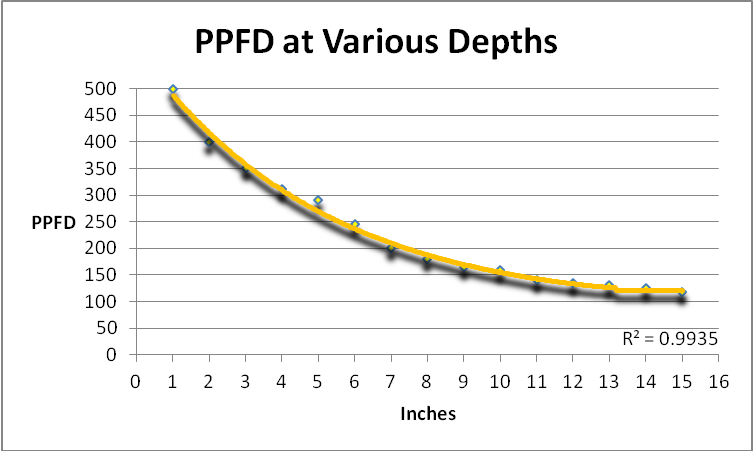
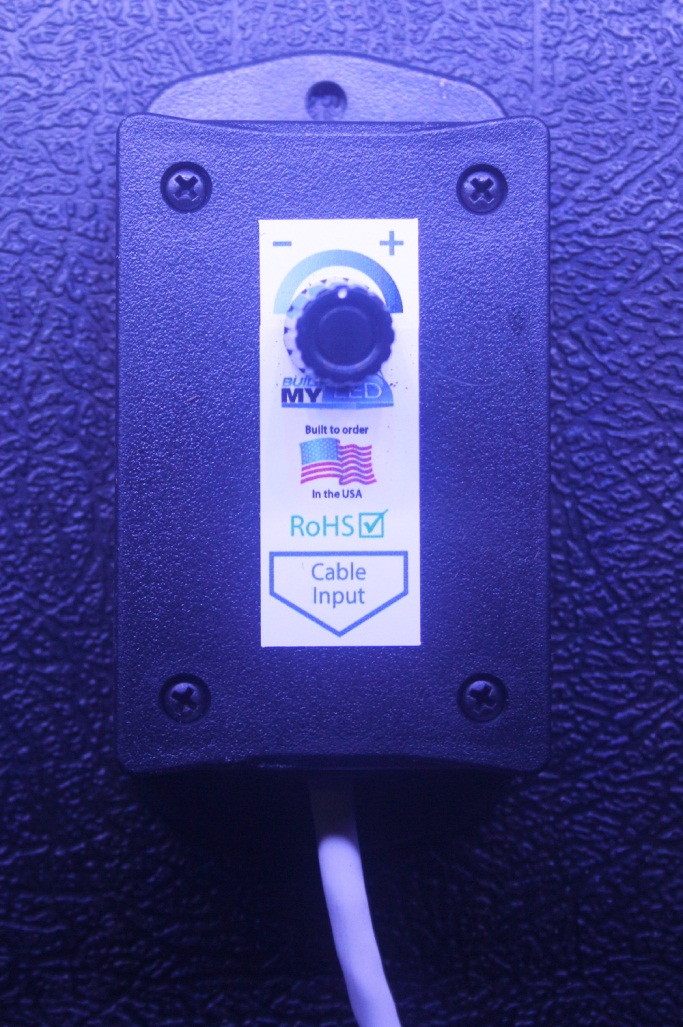

0 Comments